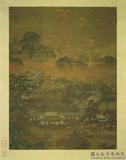清謝琯樵墨竹 軸
推薦分享
資源連結
連結到原始資料 (您即將開啟新視窗離開本站)後設資料
- 資料識別:
- 贈畫000584N000000000
- 資料類型:
- 類型:繪畫
- 型式:靜態圖像
- 著作者:
- 謝穎蘇
- 主題與關鍵字:
- 竹
- 出版者:
- 數位化執行單位:國立故宮博物院
- 格式:
- 本幅 132.7x28.5公分、全幅 36.8公分
- 關聯:
- 王新衡先生遺贈書畫展圖錄,頁12、45-46&* 謝琯樵(西元一八一一-一八六四年)本名穎蘇,福建詔安人。咸豐七年至十年(一八五七-一八六○)居留台灣,先後執教於台南磚仔橋,台北板橋林家。謝氏詩書畫皆擅長,對於台灣畫壇頗有影響。畫竹葉以「 」字為主要結組,把竹葉當作一種符號來組成,畫的是心中之竹而非眼中之竹。畫起竹葉、竹幹、竹枝,也就猶如寫書法一般運筆,一橫一豎,一撇一捺,挺勁銳利的筆劃,是以書法來作畫。&* 謝穎蘇(西元一八一一-一八六四年),福建詔安人,號琯樵。父鶴生能詩,幼承家學,九歲便能繪事,少負奇氣,工技擊,書畫皆精,尤以蘭竹著名。咸豐元年左右來台,在台期間(約一八五二-一八六一),先後受聘臺南吳家、板橋林家。後從霧峰林文察幕,與太平軍戰,殉職於漳州萬松關之役。作品頗多留臺,對臺灣書畫發展,頗具影響。本幅畫石上竹枝斜出,風姿婀娜,筆力雄健。&* Hsieh Yin-su was a native of Fukien and said to have painted by the age of 8. Gifted at painting and calligraphy, he became especially famous for his rendering of orchids and bamboo. At around 1851, he arrived in Taiwan and, until 1861, he was employed as an instructor at the Wu Family in Tainan and the Lin Family of Pan-ch’iao. Later, he was advisor to Lin Wen-ch’a and took part in the battle against the T’ai-p’ing rebels, falling at the Wan-sung Pass in Chang-chou. Many of his works still remain in Taiwan, and he is considered a major influence in painting and calligraphy here. In this work, bamboo extends diagonally from above some rocks. Blowing elegantly in the wind, the brushwork used to depict them is strong and decisive.
- 管理權:
- 國立故宮博物院
授權聯絡窗口
- 國立故宮博物院圖像授權、出版授權、影音資料授權-申請流程說明
http://www.npm.gov.tw/zh-TW/Article.aspx?sNo=03003061






